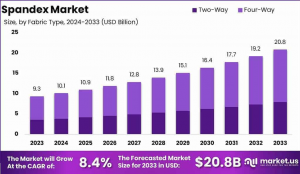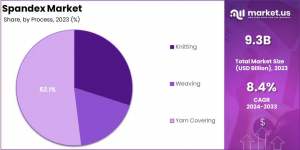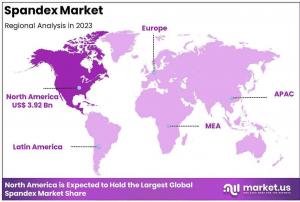The Global Spandex Market size is expected to be worth around USD 20.8 Billion by 2033, from USD 9.3 Billion in 2023, growing at a CAGR of 8.4%.
North America leads the Spandex Market with 42.2% share, valued at USD 3.92 billion, driven by high demand for performance textiles in activewear sectors.”
NEW YORK, NY, UNITED STATES, January 22, 2025 /EINPresswire.com/ -- Market Overview— Tajammul Pangarkar
The Global Spandex Market size is expected to be worth around USD 20.8 Billion by 2033, from USD 9.3 Billion in 2023, growing at a CAGR of 8.4% during the forecast period from 2024 to 2033.
The Spandex market refers to the global industry involved in the production, distribution, and use of spandex fibers, which are renowned for their exceptional elasticity and strength. Also known as Lycra or Elastane, spandex is a versatile synthetic fiber widely used in clothing, sportswear, activewear, and medical applications.
The market is characterized by a diverse range of end-use applications across multiple sectors, including apparel, healthcare, automotive, and industrial textiles. The growing demand for high-performance, comfortable, and durable fabrics is driving the expansion of this market globally.
The spandex market has witnessed strong growth in recent years, driven by a rising consumer preference for comfortable, flexible, and performance-enhancing materials in various products, especially in sports and activewear. As global health and wellness trends continue to rise, there is increasing demand for spandex in athletic wear, performance apparel, and compression garments.
In addition, government investments in the textile industry, especially in countries like China, India, and the U.S., have contributed to the growth of the market by facilitating advancements in fiber production technologies.
Moreover, regulations around sustainability are encouraging companies to innovate in creating eco-friendly spandex products. These factors combined are creating a substantial opportunity for both existing players and new entrants to expand their market presence.
For new players entering the spandex market, it is crucial to focus on innovation and product differentiation to carve a niche in the highly competitive market. Sustainability and eco-friendly manufacturing processes will become a key differentiator as consumers become more conscious of environmental impacts.
Existing players can benefit from leveraging strategic partnerships with manufacturers and textile suppliers to enhance production capabilities and reduce operational costs. The report offers valuable insights that can help companies formulate effective strategies to tap into emerging markets, strengthen their supply chain, and address evolving consumer preferences, positioning themselves for long-term success in a dynamic market landscape.
Curious About Market Trends? Request Your Complimentary Sample Report Today: https://market.us/report/spandex-market/free-sample/
Key Takeaway
-The Global Spandex Market is projected to grow from USD 9.3 billion in 2023 to USD 20.8 billion by 2033, at a robust CAGR of 8.4%.
-Four-Way Spandex dominates the fabric type segment with a 62.7% market share in 2023.
-Yarn Covering leads the process segment, accounting for 52.1% of the market in 2023.
-Clothing dominates the application segment with a commanding 73.4% market share in 2023.
-North America leads the global spandex market, holding a 42.2% share in 2023.
Use Cases
1.Athletic Wear Production: Spandex is a key material in the production of athletic wear due to its flexibility and comfort. Manufacturers are using spandex in workout gear like leggings, shorts, and tops to enhance performance and comfort during physical activities.
2. Shapewear and Compression Garments: The rise in popularity of shapewear has driven demand for spandex. Compression garments made with spandex are used to support muscles and improve blood circulation, offering comfort and enhancing body shape.
3. Swimwear: Spandex’s stretchability and resistance to chlorine make it an ideal fabric for swimwear. Brands are using spandex in swimsuits to ensure a comfortable fit, durability, and improved mobility in the water.
4. Fashion Apparel: Spandex is widely used in fashion to create form-fitting clothing, such as dresses, skirts, and jackets. Its stretchability allows for a comfortable fit, while its ability to retain shape makes it ideal for stylish, body-conscious designs.
5. Medical and Therapeutic Uses: Spandex is used in medical textiles, such as support stockings and orthopedic braces, due to its elasticity and ability to provide compression. These garments help in recovery from injuries or improve circulation in patients.
Driving Factors
Growing Demand for Activewear and Athleisure: The rise of activewear and athleisure, which combines comfort and style, is one of the key drivers of the spandex market. Spandex, known for its elasticity and flexibility, is a critical material in the production of yoga pants, sports bras, and other athletic apparel. The growing preference for fitness-oriented and stylish clothing is boosting demand for spandex-based textiles.
Expanding Applications in Fashion and Apparel: Beyond activewear, spandex is increasingly used in fashion and casual wear. It is commonly blended with other fabrics like cotton and polyester to create garments that offer stretch and a better fit. As demand for form-fitting and comfortable clothing grows, spandex is becoming more prevalent in mainstream fashion.
Technological Advancements in Fabric Development: Innovations in spandex fibers and fabric technology have led to improved quality and performance. The development of moisture-wicking, breathable, and lightweight spandex fabrics has expanded its use in both athletic and everyday clothing. As new fabric technologies emerge, spandex continues to be a preferred choice for creating high-performance textiles.
Increasing Popularity of Compression Garments: Spandex is widely used in compression garments due to its stretchability and ability to provide support. Compression socks, sleeves, and tights are becoming more popular in sports, medical, and wellness applications. This growing demand for compression wear is driving the expansion of the spandex market.
Sustainability Trends in Textile Manufacturing: The trend toward sustainability in the textile industry is impacting the spandex market. Manufacturers are exploring ways to produce spandex using eco-friendly materials, such as recycled polyester or biodegradable fibers. As consumers become more environmentally conscious, the demand for sustainable spandex products is on the rise.
Report Segmentation
In 2023, Four-Way Spandex led the global spandex market with a 62.7% share, thanks to its superior stretchability in both directions, which provides enhanced comfort and flexibility. The Yarn Covering process dominated the market with a 52.1% share, driven by its widespread use in high-performance elastic fibers for textiles and apparel. The Clothing segment was the largest application, making up 73.4% of the market, as spandex is heavily used in sportswear, underwear, home furnishings, and various other types of apparel.
By Fabric Type
~Two-Way
~Four-Way
By Process
~Knitting
~Weaving
~Yarn Covering
By Application
~Clothing
~Sportswear
~Home Furnishing
~Underwear
~Other Clothing
~Medical
~Diapers
~Compression Stockings & Surgical Hoses
~Other Medical Applications
Ready to Act on Market Opportunities? Buy Your Report Now and Get upto 30% off: https://market.us/purchase-report/?report_id=21172
Regional Analysis
In 2023, North America became the leading region in the global spandex market, capturing a significant 42.2% share, worth around USD 3.92 billion. This strong position is mainly due to the high demand for performance textiles, especially in the sportswear and activewear sectors.
The rising focus on health and fitness among consumers has led to a surge in fitness activities, boosting the need for apparel that provides excellent elasticity and comfort—key qualities of spandex.
Growth Opportunities
1. Growing Demand for Activewear
With fitness and health becoming a priority for many consumers, the demand for activewear made from spandex is on the rise. The fabric’s flexibility and comfort make it ideal for sportswear, yoga clothes, and gym apparel, presenting opportunities for manufacturers.
2. Fashion Industry Expansion
Spandex is also widely used in fashion, especially in garments that require elasticity, such as bodycon dresses, tights, and swimwear. As fashion trends continue to favor stretchy, form-fitting clothing, the demand for spandex will continue to grow.
3. Increased Popularity of Compression Garments
Spandex is key to compression garments, which are used in medical fields for things like post-surgery recovery or athletic performance. With the growing awareness of the benefits of compression wear, this market segment is likely to expand.
4. Technological Innovations in Fabric
New innovations in spandex technology, like moisture-wicking or anti-odor properties, are creating opportunities for companies to differentiate themselves. Spandex fabric that offers additional functionalities like breathability and UV protection is gaining popularity.
5. Growth in Online Retail
With the rise of e-commerce platforms, consumers are now purchasing spandex-based garments like leggings and sports bras more than ever before. Companies can expand their customer base by developing online sales channels and targeting health-conscious consumers.
Key Players
~Hyosung Corporation
~Asahi Kasei Corporation
~INVISTA
~Zhejiang Huafon Spandex Co. Ltd
~TK Chemical Corp
~Taekwang Industrial Co. Ltd
~Yantai Tayho Advanced Materials Co., Ltd
~Xiamen Lilong Spandex Co., Ltd
~Jiangsu Shuangliang Spandex Co., Ltd
~Toray Industries
~Xiamen Lilong Spandex Co., Ltd (listed twice)
~DuPont de Nemours, Inc.
~Indorama Industries
~Far Eastern New Century Corporation
~Mitsubishi Chemical Engineering Corporation
Not Sure? Request a Sample Report and See How Our Insights Can Drive Your Business: https://market.us/report/spandex-market/free-sample/
Trending Factors
Growing Popularity in Athleisure and Sportswear: The demand for spandex is being driven by the booming athleisure and sportswear market. Spandex’s flexibility, durability, and comfort make it ideal for activewear. The increasing focus on health and fitness is pushing the popularity of spandex in clothing designed for workouts, yoga, and casual wear.
Rise in Fashion and Swimwear Trends: Spandex is a key material in the fashion and swimwear industries due to its ability to provide a form-fitting look and comfort. The popularity of body-conscious fashion, swimwear, and performance wear has spurred demand for spandex-based fabrics that offer flexibility and shape retention.
Sustainability in Textile Production: The textile industry is seeing a shift toward sustainable and eco-friendly spandex production. Consumers are looking for materials that have a lower environmental impact, which is driving innovation in the development of recycled spandex and more sustainable manufacturing processes.
Technological Improvements in Fabric Performance
Manufacturers are constantly improving the performance of spandex fabrics, making them more durable, moisture-wicking, and breathable. New innovations such as anti-bacterial and UV-resistant spandex are opening up new markets, especially in outdoor sports and activewear.
Increase in E-commerce and Online Shopping: The rise of online shopping is also boosting the spandex market, as more consumers buy clothing online, especially activewear and fashion. Online retailers are able to offer a wide variety of spandex-based garments, catering to different body types, preferences, and budgets.
Restraining Factors
1. Fluctuating Raw Material Prices Spandex is derived from chemicals like polyurethane, and fluctuations in the price of these raw materials can increase production costs. When raw material prices rise, manufacturers are often forced to either absorb the cost or raise prices for consumers. This can reduce demand, especially in price-sensitive markets.
2. Environmental Concerns The production of spandex involves significant chemical processing, which can be harmful to the environment. Growing concerns over sustainability and the environmental impact of synthetic fibers are leading to stricter regulations and increasing demand for eco-friendly alternatives. This shift toward sustainability could limit the growth of the traditional spandex market unless companies adopt more environmentally responsible production practices.
3. Intense Competition from Alternative Materials Spandex faces competition from other elastic and stretchable materials, such as polyester, elastane, and natural rubber, which may offer similar properties at a lower cost. As alternatives continue to improve in performance and cost-effectiveness, spandex may lose its market share, particularly in sectors like apparel and activewear, where cost sensitivity is high.
Conclusion
The Global Spandex Market is poised for significant growth, projected to reach around USD 20.8 billion by 2033, expanding at a CAGR of 8.4%. This robust growth trajectory is underpinned by the increasing demand for versatile, high-performance fabrics in various sectors, including fashion, sportswear, and healthcare. As consumer preferences evolve towards more durable, comfortable, and sustainable products, spandex manufacturers are pressed to innovate and improve product offerings.
The industry faces challenges such as stringent environmental regulations and the need for sustainable manufacturing practices, pushing companies to explore eco-friendly production methods and materials. Meanwhile, technological advancements in fabric performance and an expanding range of applications continue to open new avenues for growth. Companies that successfully integrate consumer trends towards sustainability, enhanced functionality, and cost-effectiveness into their operations are well-positioned to capitalize on the dynamic opportunities within the global spandex market.
Lawrence John
Prudour
+91 91308 55334
email us here
Visit us on social media:
Facebook
LinkedIn
Legal Disclaimer:
EIN Presswire provides this news content "as is" without warranty of any kind. We do not accept any responsibility or liability for the accuracy, content, images, videos, licenses, completeness, legality, or reliability of the information contained in this article. If you have any complaints or copyright issues related to this article, kindly contact the author above.




